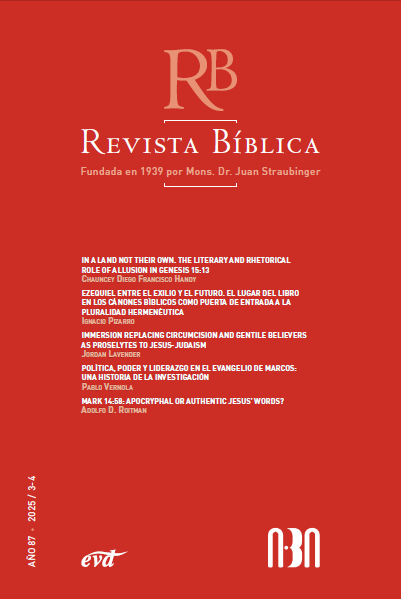En una tierra que no es la suya
El papel literario y retórico de la alusión en Génesis 15:13
DOI:
https://doi.org/10.47182/rb.87.n3-4-2025449Palabras clave:
Génesis, Egipto, Pentateuco, Abraham, lector implícitoResumen
Sostengo que en Génesis 15,13 la frase “en una tierra que no es la suya”, be’ere? l?’ l?hem, opera en múltiples niveles retóricos para los antiguos lectores judíos de la diáspora. En primer lugar, presagia la esclavitud y el éxodo de Egipto, conectando así literariamente el ciclo de Abraham con lo que vendrá más adelante en el Éxodo. En segundo lugar, la vaguedad del término, en lugar de decir simplemente “Egipto”, facilita la conexión de la narrativa patriarcal con la experiencia vivida por los lectores de la diáspora. “Una tierra que no es suya” se refiere tanto a Babilonia (u otros lugares) como a Egipto.
Citas
Abraham, J., “The Covenant between the Parts”, Jewish Bible Quarterly 36 no. 4 (2008) 231-242.
Anbar, M., “Genesis 15: A Conflation of Two Deuteronomic Narratives”, Journal of Biblical Literature 101 no. 1 (1982) 39-55.
Ben-Mosheh Ben-Asher, A. – K?h?n, M. (eds.), Miqraot gedalot haketer (Bereshit 1) (Hadpasa 2), R?mat-Gan 2008.
Brettler, M. Z., How to Read the Bible, Philadelphia (PA) 12005.
Carr, D., “Narrative and the Real World: An Argument for Continuity”, History and Theory 25 no. 2 (1986) 117-31.
Fidler, R., “Genesis Xv: Sequence and Unity”, Vetus Testamentum 57 no. 2 (March 1, 2007) 162-180.
Friedman, R. E., Who Wrote the Bible? (reprint edition), San Francisco (CA) 1997.
Hasel, G. F., “The Meaning of the Animal Rite in Genesis 15”, Journal for the Study of the Old Testament 19 (1981) 67-78.
Iser, W., The Implied Reader: Patterns of Communication in Prose Fiction from Bunyan to Beckett, Baltimore (MD) 1978.
Peleg, Y. (I.), “Was the Ancestress of Israel in Danger?”, Zeitschrift Für Die Alttestamentliche Wissenschaft 118 no. 2 (January 1, 2006) 197-208.
Römer, T., “The Exodus in the Book of Genesis”, Svensk Exegetisk Årsbok 75 (2010) 1-20.
Sarna, N. M., Genesis =: Be-Reshit: The Traditional Hebrew Text with New JPS Translation (The JPS Torah Commentary), Philadelphia (PA) 1989.
Schmid, K., “Genesis in the Pentateuch”, in A. Craig – A. Evans – J. N. Lohr – D. L. Petersen (eds.), The Book of Genesis. Composition, Reception, and Interpretation (Supplements to Vetus Testamentum, v. 152), Leiden 2012, 27-50.
Ska , J.-L., Introduction to Reading the Pentateuch, Winona Lake (IN) 2006.
van Wieringen, A. L. H. M., The Implied Reader in Isaiah 6-12, Leiden 1998.
von Rad, G., Genesis – A Commentary (revised edition), Philadelphia (PA) 1973.
Wenham, G. J., “The Symbolism of the Animal Rite in Genesis 15: A Response To GF Hasel, Jsot 19 (1981) 61-78”, Journal for the Study of the Old Testament 7 no. 22 (1982) 134-37.
Wenham, G. J. – Hubbard, D. A. – Barker, G. W. – Metzger, B. M., Genesis 1 – 15 (Word Biblical Commentary 1), Waco (TX) 1987.
Westermann, C., Genesis 12-36, Minneapolis (MN)1995.
Zakovitch, Y., “Juxtaposition in the Abraham Cycle”, in D. P. Wright – D. N. Freedman – A. Hurvitz (eds.), Pomegranates and Golden Bells:
Studies in Biblical, Jewish, and Near Eastern Ritual, Law and Literature in Honor of Jacob Milgrom, Winona Lake (IN) 1995, 509-24.
Publicado
Cómo citar
Número
Sección
Derechos de autor 2025 Revista Bíblica

Está obra está bajo licencia Creative Commons Attribution-NonCommercial-ShareAlike 4.0 International License.




